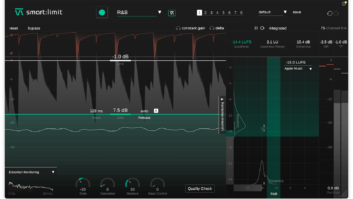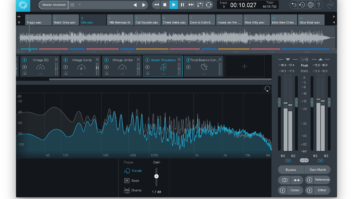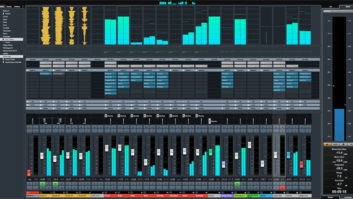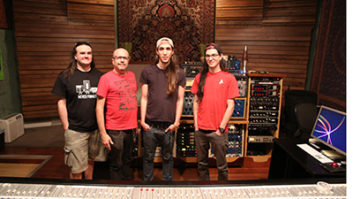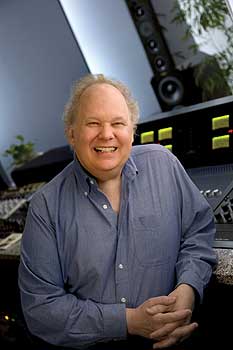
Bob Ludwig of Gateway Mastering
These are tricky times for mastering engineers. While one could argue that mastering engineers are always “mixing,” the line between mixing and mastering is blurring. Certainly, low-cost tools have lowered the bar of entry for artists and engineers, and demystified some of the processes involved; lower budgets have put a crunch on overall productions, squeezing projects especially at the end stages; and, quite simply, with the number of options available through DAW recording, decisions tend to get delayed.
It’s important to distinguish the difference between making fine mix adjustments in the mastering room and finishing the mix during mastering. The latest trend to enter the mastering room — the provision of mix stems accompanying a ref — can put the mastering engineer between a rock and a hard place. When yours are the final ears on a project that a producer, engineer and artist have presumably labored over for months, how much can you be expected to do? How much do you want to do?
Mix Stems and the Mastering Engineer
Stems — the separated elements of a final mix — are increasingly showing up in mastering rooms, a trend welcomed by many engineers as an opportunity to fine-tune, not finish, the mix. “I would say it’s not my preference to mix anything,” says Bob Ludwig (Radiohead, Bruce Springsteen, Pearl Jam, Coldplay) of Gateway Mastering (Portland, Maine). “I get to work with some of the world’s greatest mixers, and I would never want to step on anybody’s toes, so it’s best to have something that the artist has approved beforehand and the A&R person has approved, and everybody’s happy. Just send me the final thing. But having said that, if the artist is not happy with the vocal levels, for instance — which is what most of it comes down to — then it’s actually cheaper to have us, or the remixer, go back to the stems that the mixer might have created. Instead of having to hire the mix studio again and go back with a big expensive console, they can take the stems and correct the odd vocal word usually right in Pro Tools or some other workstation, or they can do a special vocal-up mix from the stems very easily.

Jennifer Munson of Taloowa Mastering
“For years, great mixers like Bob Clearmountain would routinely do a master mix — a choice mix, he would call it; a vocal up a half dB, perhaps a vocal up 1 dB and, occasionally, a vocal down a half dB or something, and then do an instrumental mix, a TV mix and now very often an a cappella mix so that vocals can be mixed back,” he continues. “At the same time, we just did a new Natalie Merchant record — a fantastic record. All of the lyrics are based on children’s poetry that was written in the late 1880s and early 1900s. While most of it was mixed to half-inch, the producer made sure to have everything on stems as well.”
New York mastering engineer James Cruz spent long stretches at Hit Factory and Sony before opening his own facility, Zeitgeist Sound Studios (Long Island City). He recently mastered projects by Beyoncé and Calle 13, and the latter earned five Latin Grammys in ’09, including Album of the year. Cruz, who also works occasionally as a mixing engineer, enjoys the flexibility of working with stems, yet is careful to maintain a mastering perspective. “Sometimes I’ll actually get an 8-channel file of everything so I can tweak the mix a bit here and there,” he says. “Yes, I’m making slight mix decisions at that point, and there are other mastering tools that I can use to make slight mix decisions, like different styles of EQ to bring out the stereo image or tighten it a little bit more. The more freedom I have, the better the end result is going to be. I’m not saying that I would use all of those options, but it’s good to have them.”

Zeitgeist Sound Studios’ (New York City) mastering engineer James Cruz
He emphasizes that he would take the same mastering approach whether or not he was dealing with stems, “but as I’m mastering it and I’m listening to it, and thinking, ‘It’d be great to hear that vocal out a little bit more or hear the vocal down a little bit more,’ or, ‘It’d be great if that kick drum would come out a little bit more,’ I can’t do it with EQ, because by bringing up the kick drum I’m also bringing up the string bass and everything just starts to get a little bit muddy. If I could just reach over to my Pro Tools and nudge the kick drum up a little bit, the kick drum is up a little bit without ruining the feel of the entire mix.”
Andrew Mendelson, owner and chief mastering engineer of Georgetown Masters (Nashville), appreciates having access to mix elements, but notes that working with stems can sometimes change the vibe of a session. “It changes the workflow a little bit,” says Mendelson, who has mastered artists such as Kenny Chesney, Ricky Skaggs, the Rolling Stones and White Stripes. “It seems like in audio production in general, people have a tendency to push things off to the next stage and there’s certainly the risk of [waiting to figure out mix issues in mastering].”
Gavin Lurssen, of Lurssen Mastering in Hollywood, has mastered projects ranging from Spinal Tap to the Grammy-winning Robert Plant and Alison Krauss collaboration Raising Sand. He says the line is blurred to the point that several of his clients don’t even want to hear their mixes until they’ve been mastered. “What some of them are doing is, if their budget can support it, they’ll come see me to get an idea of what the finished product will sound like before mixing is done,” he says. “They’ll go back, they’ll make adjustments with the end result in mind, because they want to know what it’s going to sound like when I’ve mastered it.”

Gavin Lurssen of Lurssen Mastering in Hollywood
Of course, mixing options in mastering are often defined by the media format. “Predominantly, we’re getting files off the Internet and they’re mixed down to 2-track; I almost never deal with stems. Instead, my husband has designed an MS processing system that allows us to alter vocal levels and other relative balance issues easily and quickly, even in a stereo track.” says Jennifer Munson, who engineered at Gateway and Sony Classical and has mastered music from artists ranging from Isaac Stern to Busta Rhymes. She now divides her time between mastering at her own facility, Taloowa Mastering, and engineering the On the Media program for NPR. “Often [stems are] offered if they’re talking to me directly at the start of a project. I’ll listen to one track or something like that, give them feedback on what I’m hearing and then the rest of the album usually comes back just fine.”
Summing choices also can influence mastering options. Mendelson says that when mixing on a console through a series of outboard gear, when stems are printed through that chain, the stems summing together through those 2-channel devices will not sound the same as sending each individual track through those devices and then summing behind them. “Sometimes pulling the stems together, the sum of all the elements doesn’t actually create the master mix. So you’re going to have to make a choice: Are the stems better to work with than the master mix, which was signed off on? Because before you even touch a knob, you’ve got an inherent change in the sound.”

Andrew Mendelson of Georgetown Masters
“Mastering engineers can get good summing buses to deal with stems,” adds Lurssen, “but problems can arise when engineers bring in stems and want to go back and make minor mix adjustments. And then, because they want to adjust one balance in the mix, they might raise the guitar half a dB, but they end up going through a summing bus that will degrade the whole thing. That process can mean taking one step forward and four steps backward.”
Different Goals, Different Mixes
As the loudness wars drag on, in an effort to satisfy A&R with a “competitive” mix while providing mastering engineers some dynamic breathing room, mixing engineers may resort to creating two distinct reference mixes — a heavily compressed version for the clients and a less-compressed version for mastering. The danger? Mastering engineers are working from a different point of reference from the client. Further complicating matters is the idea that CD mix references physically resemble a finished product, influencing client expectations, explains Lurssen.
“It used to be that you would get a lacquer vinyl reference or a DAT ref, even a cassette ref,” Lurssen says. “But when CDs became affordable in the ’90s, all the mix rooms started using CD refs.” Increasingly, he says, artists, comparing their unmastered CD references to commercial CD releases, began to question why their music wasn’t as loud. “Mixers would run everything through an L2 or a Finalizer and crank it up, and they would come into the mastering room and it would be pretty hot,” Lurssen continues. “And the mastering community would say, ‘Can you give me something that’s not quite as hot?’ And we would get something that was not quite as hot, but the bands would say, ‘Hey, this isn’t what I remember it sounding like.’ Because the mastering engineer is working on something that the artist hasn’t even heard. The artist needs not only to really hear the [actual] mix, but the artist needs to understand that if it hasn’t gone through the process of mastering, it’s not going to sound like a commercial CD.”
Lurssen feels the line between mixing and mastering is more blurred for the client than to the engineers along the chain. “You have to educate people from scratch; there’s a responsibility that goes into audio processing,” he says. “I usually get to know somebody before they come and see me, and I go through all this with them, which is time-consuming, and in this business time is money. They don’t even realize that this is where the value of their mastering session starts.”
Munson agrees that clients and artists often do not understand the mastering process — a problem that is sometimes perpetuated by attempts to make the clients happy with a mix before it has been mastered. She adds that there is a lot of weight on the mix engineer to be a buffer between artists and mastering, to keep mixes at a reasonable level. “Just having a mix engineer who’s saying, ‘This is how it’s going to be, just turn it up, listen to it and know that the end result is going to improve dramatically after mastering if the mix is not crushed’ — having someone who gets that process, who can convince their clients of this, I think that’s the hard part.”
“I’m a big proponent of starting with what’s been approved, what everyone is liking so we’re all on the same page,” says Mendelson. “When [mix engineers] remove all those compressors when they send it to me, now I’m starting with a mix that’s totally different than what’s been approved. And I understand the intention was to give me more room to work, but it’s really important if you’re going to do that to also send what people have been approving, even if it’s nothing more than a 16-bit/44.1k reference.”
Knowing Enough to Be Dangerous
Just as merely owning Pro Tools doesn’t make someone a recording engineer, having a mastering plug-in doesn’t make someone a mastering engineer. “People put these plug-ins on stuff, it makes it louder and it makes it more compressed, and it makes levels a lot closer to being even, but it’s not a substitute for a trained set of ears and all of these things we are doing,” says Cruz. “[Mastering plug-ins are] just squashing the hell out of everybody’s mix. They’re taking all of this time to make this great-sounding mix and convey the emotions of the artist, then to just strap one of these things across the mix just squashes everything down, killing all of the life and all of the emotion in it.”
In addition, Mendelson notes that simply labeling tools “mastering EQ” and “mastering compressor” perpetuates the misconception that mastering is purely about processing, as opposed to the broader process of creating a high-quality master — and that philosophical change leads people to take things into their own hands who might otherwise not have done so.
“There’s a lot more to mastering than the processing,” he says. “That’s one element. But I have a staff of four people who assist me doing all kinds of other work, in terms of production and quality control. It is like a bridge between the creative aspect and the distribution side of making a work of art — making a proper DDP image, Red Book-compatible CD or, in the case of surround sound or audio-for-video, ensuring optimum quality data compression where necessary, making sure ISRC and UPC codes are entered correctly, making sure that CD text is entered correctly, doing a final QC and making sure that nothing’s amiss. It’s a last stage to find any flaw before you go to make a whole lot of copies.”
Mastering engineers agree that although technical and economic factors may cause them to work differently, they remain true to their focus. “As far as my role changing, it’s only in the sense that I can do things that maybe I once couldn’t as my tools get better,” says Mendelson. “But I still view my role as a mastering engineer as somebody who takes the finished mix and makes that final mix entity sound as good as it possibly can.”
Sarah Jones is associate director of Women’s Audio Mission, a San Francisco-based nonprofit dedicated to advancing women in the recording arts.
